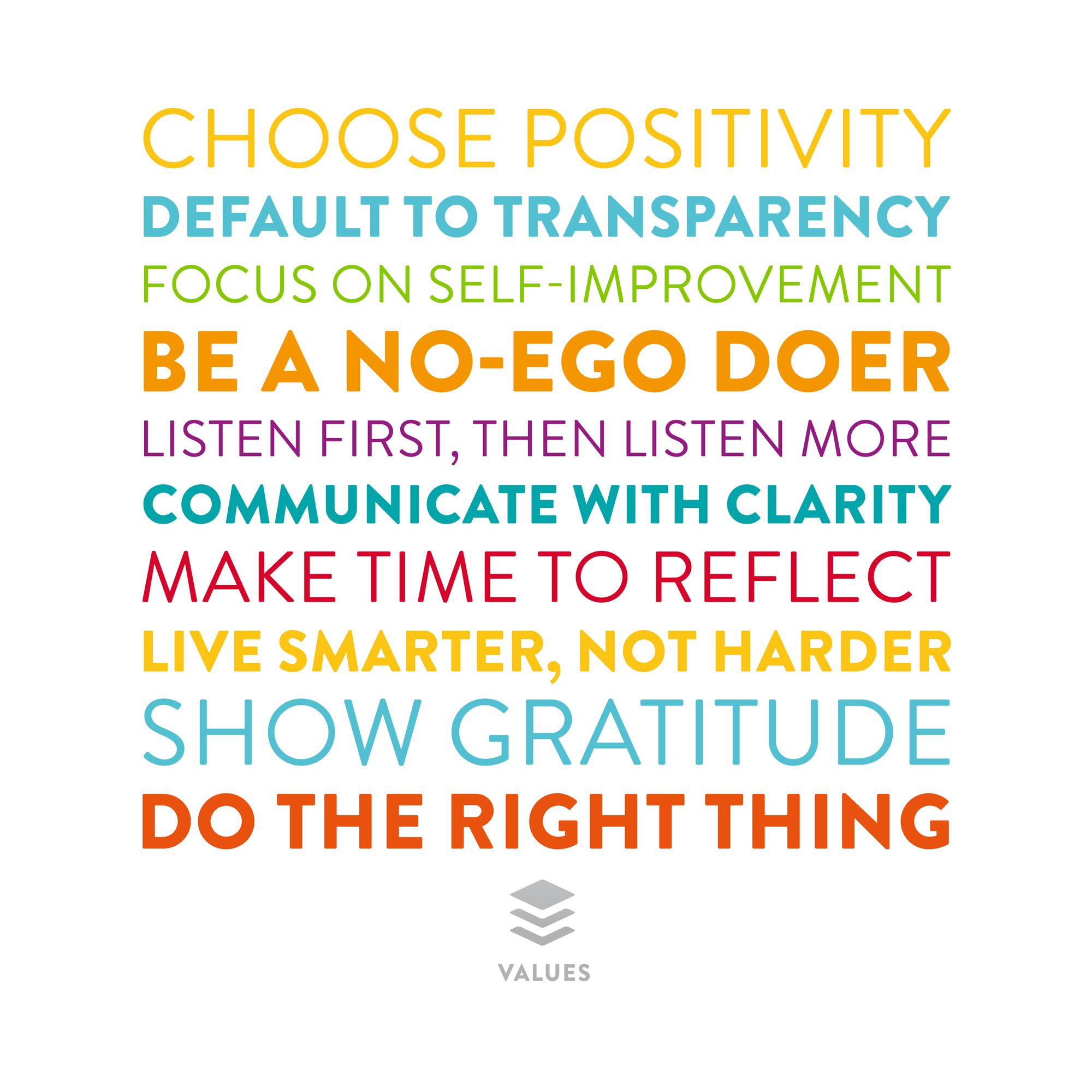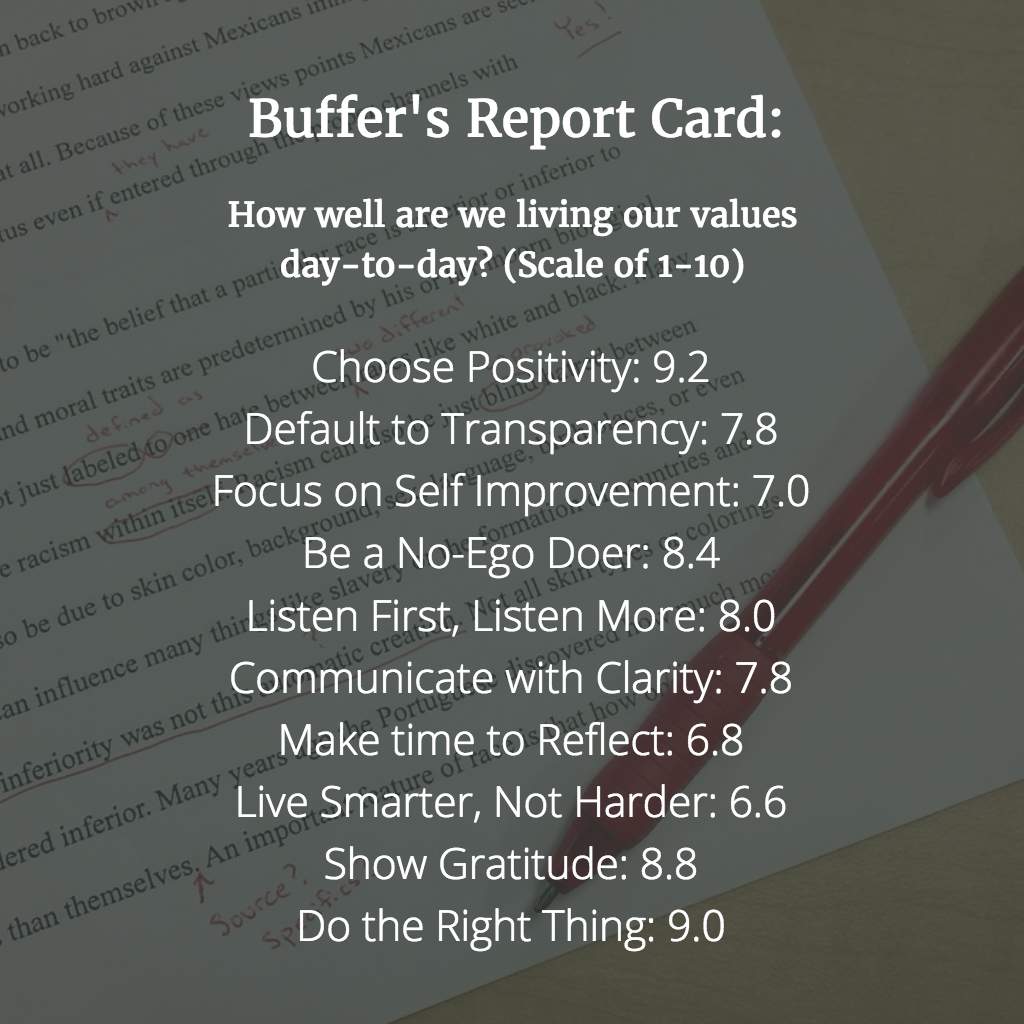
What A Team Survey Revealed About The Way We Live Our Company Values
Director of People @ Buffer
Our company values are the foundation upon which our team has grown and our product has developed. They emerged in the early years of Buffer when we were a small team of 10 people, and they have guided us ever since, leading to a number of work culture experiments and lessons along the way.
In all, we have 10 values that we aspire toward:

To us, these values are motivating and inspiring. We talk about them all the time whenever we see a great example of a value in action or we experience a situation where our values are needed. We memorize these values. We put values onto stickers. We teach values to our Slack bot.

But how well do we live up to our values?
How would we grade ourselves on whether the values we talk about all the time are the values that are truly felt and experienced day-to-day at Buffer?
To find out, we asked. In line with our value of reflection — Make Time to Reflect — we sent a survey to our team to better evaluate how we are living these values in our (digital) Buffer workplace. And we found several areas to improve!
Here are the full results and what we’re doing to improve.
Our values scores: High marks on positivity, room to improve with working smarter
We sent out a survey to our 73-person team, asking about each of our values and how well we are living them day-to-day. Teammates were asked to rate each value on a scale of one to 10 with one being “Needs a lot more work” and 10 being “Strongly living.” Sixty teammates responded.
Here is how we scored:

Overall, we’ve held steadfast in many areas like Choose Positivity and Do the Right Thing, though some of our values have slipped, specifically in Living Smarter, Not Harder and Make Time to Reflect.
Let’s dive in even deeper!
4 Things We’re Doing to Improve our 4 Lowest Scores
We had a hunch about some of the pain points we’ve been feeling lately thanks to hints from teammate feedback via our team engagement tool, Officevibe, and personal interviews with team members. This report card confirmed those. The exercise really opened our eyes to the most neglected areas in our company values and helped reaffirm where we can best focus. There’s no time like the present to work on our pain points.
We did this survey in February of this year and since then we’ve been making a few key internal changes to start working on the areas where we could definitely improve.
1. Live Smarter, Not Harder
What we’re doing now: The 5-in–6 Rule
After we uncovered that our unlimited vacation didn’t lead to people taking very much time off, we adjusted to a three-week minimum vacation policy and are using the tool Timetastic to track and transparently share in Slack when teammates are offline.
With the new focus on a minimum of three weeks (and in an effort to ensure we all don’t “forget” and end up taking the final three weeks of the calendar year off!) the People team has started doing quarterly vacation checks in line with the 5-in–6 Rule.
The 5-in–6 rule is when we look at our data in Timetastic and note anyone who has taken fewer than five days off in the past six months. We found about 15 teammates who hadn’t taken much time at all (and didn’t have any time off planned in the app).
This threshold is entirely subjective and might fluctuate from quarter to quarter. We’ve heard from leads and direct reports that this was a helpful exercise and has prompted some to get time off on the calendar.
2. Make Time to Reflect
What we’re doing now: Encouraging a team-wide reflection hour
Harvard discovered, “We do not learn from experience … we learn from reflecting on experience.”
In the fast-pace of a startup, it’s easy to forget to pause and evaluate yourself, your role, your tasks, and your goals. It’s perhaps the hardest thing to set aside time for things that are important but not urgent.
We experimented with one hour set aside in a week for our teammates to feel like they had the freedom to disconnect and simply think.
We encouraged everyone to block our one hour of reflection time on their calendar at some point in the day to write, meditate, go for a walk, or do anything that would allow our teammates to spend some time in thought. We were also keen to have everyone not check email, turn off their notifications, and tuck their phones out of sight.
In practice, we didn’t have too many feel they could participate, but we feel that this experiment was validated to do on a regular basis. Most who participated said they journaled, meditated or simply went for a walk.
Those who took part said they felt it was a valuable use of their time and many others said they hoped to make this a regular practice on their own or take part in another team-wide Reflection Hour.
Another practice that our Happiness team has recently instituted is building in a 5-minute window before their one-on-one chats with their leads where both parties check in via Slack and say, “Hey I’m excited to chat in a few minutes – shall we take some time to reflect and prepare for our 1:1?”
Our leads say that while this time is short, it has been powerful.
3. Default to Transparency
What we’re doing now: Sharing notes from leadership meetings with the whole team
It might surprise many that transparency could be something we on the team feel like we’re lacking at the moment since we’re known for sharing so much at Buffer.
For a bit of added context, we generally do even more transparent sharing within our own team than we do with the world, but we’ve definitely let that slip in the past year. The main reason is because we’ve been moving faster than our internal organization guidelines could keep up and our team is a lot larger than when those guidelines were initially put into practice.
We’ve made some large leaps in our internal transparency lately to make it top of mind again.
Mainly, we’ve refocused on having leads and the leadership team share everything that they can in Discourse, or in public Slack channels, where the whole team can access it.
On a team level, our Director of Happiness, Åsa, sent a note to the whole Happiness team kicking off a conversation about transparency:
“Feels like over time we have slipped into keeping discussions and decision making within in the Happiness Leads team and we have lost a lot of the shared ownership and transparency the smaller Happiness team once had. I’d like to make change this and am very excited about how we can involve more team members in decision making and ownership in various areas that we may not have explored for a while.”
To remedy this, there’s now a public Slack channel where Happiness leads discuss overall strategy that they used to discuss in a private channel. Happiness reports that the leads send to Åsa will be cc’d to the whole team and the notes from weekly happiness leads sync will be shared transparently as well.
Across the whole Buffer team, one thing we’ve been focused on is making transparent the things that the leadership team is working on and discussing before decisions are made.
In practice, this looks like meeting notes from all leadership syncs being shared with the whole team and the breakdown of what the leadership team talked about on their retreat (after our team-wide retreat in Madrid) also being sent around to the whole team.
Transparency isn’t easy. It takes work, commitment, and communication. It’s something we realize we need to intentionally focus on because it won’t happen on its own.
4. Communicate with Clarity
What we’re doing now: Moving away from Slack and towards asynchronous communication
We’ve come to rely on Slack as our main form of communication team-wide. We love Slack, but have realized it has created an urgency culture that has left many teammates feeling they need to be available on Slack to respond 24/7 (this feeds into our number one problem value, living smarter, not harder.)
The problem is, Slack is not very asynchronous. For a team spread across 50 different cities, it can be a challenge for us as we rely on asynchronous communication to get things done.
One teammate summed up many of our challenges in our survey comments: **
“..for ‘Live Smarter, Not Harder’– I’ve often felt this isn’t very possible when I’m expected to have Slack open all day and there is ongoing chatter in the channels I’m a part of. Totally realize this is a part of working remote and being fully distributed and maybe is just necessary, but also feel like certain teams are tied to the task of ‘keeping up with everything’ while trying to accomplish what needs to be done. Wish I had solutions to propose, I get it’s a really tricky challenge.”
We’re exploring better means to communicate asynchronously as a team — through our existing systems of Discourse, e-mail, and through potential new tools.
In May, we launched an internal document entitled, “The Slack Agreements of Buffer” that outline a set of tips and general guidelines for our team members to follow in regards to one of our most heavily used communication tools, Slack.
This included how we use Slack, a list of our current channels and a few special permissions to truly use the tool in a working smarter way. For example, “Kill/modify Slack when you need to focus: Which doesn’t necessarily mean quitting it. You can set yourself away, or activate Do Not Disturb, or set your status to a focus mode when you want to focus on something without being interrupted.”
What this exercise taught us
Overall, this self-evaluation revealed how off-track some of our core values had diverged from daily practice and has helped us start to make moved towards improving them.
We’re excited to do this exercise again next year at the beginning of the year, in the hopes that it will help set the tone for how we can improve over the year.
Over to you
We’d love to hear from you in the comments!
- Do any of these grades surprise you?
- Does your company have a set of values?
- What values do you personally focus on each day?
Try Buffer for free
140,000+ small businesses like yours use Buffer to build their brand on social media every month
Get started nowRelated Articles

How the Buffer Customer Advocacy Team set up their book club, plus their key takeaways from their first read: Unreasonable Hospitality by Will Guidara.

In this article, the Buffer Content team shares exactly how and where we use AI in our work.

Here we go again. If you work in social media, it’s nothing new to adapt and change your strategy based on the ever-changing algorithms and the rise and fall of social networks. (Who else was on Vine? 🙋🏻♀️) But, of course, we wish you didn’t have to. The latest wave for social media marketers and creators is that TikTok might be banned in the U.S. The short-form video app has become one of the most widely-used social media platforms and is credited with impacting trends and cultural shifts.